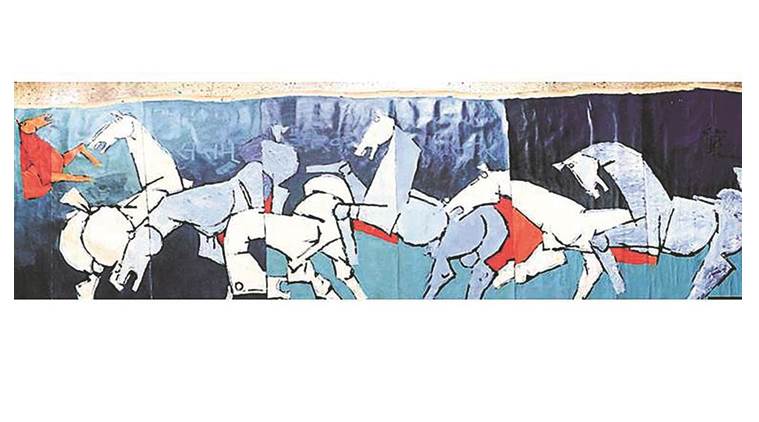‘The palace is being readied for the Maharaja’
Around 200 works from the Air India collection will be showcased at the refurbished front wing of NGMA’s Jaipur House in Delhi

A work by MF Husain that is a part of The Maharaja Collection
IT WAS in the month of July, as the proposed sale of Air India’s Nariman Point in Mumbai building started to take shape, that the focus shifted to its priceless art collection. “The Maharaja Collection” has over 4,000 works, including paintings by legendary artists such as Jatin Das, Anjolie Ela Menon, MF Husain and VS Gaitonde. Soon, news came in that the collection will be handed over to the Ministry of Culture and become part of the repository of the National Gallery of Modern Art (NGMA) in Delhi.
Ever since, the national gallery has been preparing for the arrival of the treasure. A mega facelift of its galleries and the storage facilities is underway. Adwaita Gadanayak, Director-General, NGMA, says, “It’s only in the fitting that the palace be readied to welcome the Maharaja.” Once the works arrive at NGMA, and their condition is assessed, some of the works will be displayed at the Jaipur House building to inaugurate the new exhibition area in the front wing.
“This heritage building used to be the palace of the Maharaja of Jaipur before Independence. Now, as we are redoing the interiors of the front wing, we are discovering rooms and corridors, windows and motifs that are typical of royalty. We thought this would be the best place to showcase the Air India exhibits,” says Gadanayak, adding that illumination of the facade is also in the works.
“This heritage building used to be the palace of the Maharaja of Jaipur before Independence. Now, as we are redoing the interiors of the front wing, we are discovering rooms and corridors, windows and motifs that are typical of royalty. We thought this would be the best place to showcase the Air India exhibits,” says Gadanayak, adding that illumination of the facade is also in the works.
The works have already started arriving on Air India planes from Mumbai, and are perhaps being opened for the first time in several decades. They had been packed in cartons and tucked away in the storehouse of the Nariman Point building ever since the airline’s fortunes started dipping. Unfortunately, some of the works from the collection have been lost, stolen or damaged over time, while the rest have been gathering dust in the stores of the building.
The collection was built over six decades after Independence, driven by JRD Tata’s philosophy of “putting a little bit of India” in the offices of the erstwhile Tata Airlines. While some of the works were commissioned by the airline and some were bought for as low as Rs 50-500, others were bartered for air tickets to artists travelling abroad, as former Air India CMD V Thulasidas mentioned in 2008. In an interview, Husain had said: “They (Air India) would take the paintings and give free air tickets in return. As a result, the artists could travel to Czechoslovakia, Hong Kong and Paris. I did about four or five trips.”
The collection was built over six decades after Independence, driven by JRD Tata’s philosophy of “putting a little bit of India” in the offices of the erstwhile Tata Airlines. While some of the works were commissioned by the airline and some were bought for as low as Rs 50-500, others were bartered for air tickets to artists travelling abroad, as former Air India CMD V Thulasidas mentioned in 2008. In an interview, Husain had said: “They (Air India) would take the paintings and give free air tickets in return. As a result, the artists could travel to Czechoslovakia, Hong Kong and Paris. I did about four or five trips.”
It is considered to be one of the most important collections of modern Indian art because, at the time, Air India was the only source of patronage for impoverished artists as the royalty had ceased to exist. The national carrier used the artwork to adorn its offices in India and abroad, and also to print on its calendars, posters and menu cards.
Gadanayak says, “The nature of the display will depend on the condition of the works, whether they need any conservation or restoration. Also, the entire collection is too huge to be put on display at one time. We will start with around 200-250 works.” Gradually, smaller exhibits will also travel to the NGMA’s campuses in Bengaluru and Mumbai. He adds, “The entire collection will also be neatly archived and catalogued.”
Gadanayak says, “The nature of the display will depend on the condition of the works, whether they need any conservation or restoration. Also, the entire collection is too huge to be put on display at one time. We will start with around 200-250 works.” Gradually, smaller exhibits will also travel to the NGMA’s campuses in Bengaluru and Mumbai. He adds, “The entire collection will also be neatly archived and catalogued.”
No official estimates exist of the worth of the entire collection. As the works arrive in batches, three kinds of assessment will be done — those that are ready for display, those that need minor restoration, and those that need major work. Accordingly, around 200 works will be put on display in October, says an official from the Ministry of Culture.
Around Rs 10-15 crore is being spent on the facelift at NGMA, which has an October deadline. It’s the first such exercise being carried out here since the building was given to run the NGMA — which, today, has 10,000 works in its repository — in 1954. Major emphasis is being put on the storage space, where climate-controlled conditions and state-of-the-art lab are being created for the artwork.






















No hay comentarios:
Publicar un comentario